The Swedish National Board for Assessment of Research Misconduct (NPOF) made a decision, finding the Karolinska Institutet researcher Leonard Girnita and his wife and lab colleague Ada Girnita guilty of research misconduct.
The Girnitas have around 25 papers on PubPeer, most are however over 10 years old, that is why NPOF investigated only the four most recent of them, established fraud, and blamed not only the two principal investigators but also several of Girnitas’ coauthors and lab members. Both Girnitas are Romania-born and both trained in USA under Carlo Croce‘s equally dishonest academic offspring George Calin and under Karolinska’s own questionable professor Olle Larsson, now retired.
Read the story here:
Croce begat Calin, and Calin begat Girnita…
An academic dynasty of bad cancer research.
In 2018, Leonard Girnita said in an interview with a Swedish funding agency:
“I am basically a doctor and have worked with cancer research and treatment throughout my professional life. The main driving force is the passion to help people and contribute to a better life for everyone affected by cancer, to make a difference.”
Hallå där Leonard Girnita! (2018)
His wife used to be a regular feature on Swedish TV and radio. The melanoma expert was advising viewers on sun exposure (for example here , here, here and here). Who could have known that the real danger to public health was not in the mild Swedish summers, but in the fake cancer research Ada Girnita and her husband published?
Here a rather representative paper by Girnita and Larsson, with almost 20 years too old unfortunately to be investigated by NPOF:
Charlotta All-Ericsson, Leonard Girnita, Anja Müller-Brunotte, Bertha Brodin, Stefan Seregard , Arne Ostman, Olle Larsson c-Kit-dependent growth of uveal melanoma cells: a potential therapeutic target? Investigative Ophthalmology & Visual Science (2004) doi: 10.1167/iovs.03-1196


I reported the Girnita case to Karolinska and NPOF in May 2022, in September 2022 the pseudonymous sleuth Clare Francis (who posted the evidence on PubPeer) made another notification to NPOF. On 11 December 2023, NPOF issued its final report, which we received on 14.12.2023. Its main findings are (Google-translated):
“The National Board for Assessment of Research Misconduct (the Board) decides that Sonia Cismas, Caitrin Crudden, Ada Gimita, Leonard Girnita. Daniela Nedelcu, Takashi Shibano, Dawei Song, Naida Suleymanova, Eric Trocme, Claire Worrall and Huiyuan Zheng are guilty of research misconduct .
The National Board for Assessment of Research Misconduct decides that Elisabeta Candrea, Iara Trocoli Drakensjo, Julian Oprea, Stefan Seregard, Julianna Serly, Hongchang Shen and Radu Stefanescu are not guilty of research misconduct”
The Girnita couple get blamed in particular:
“The Board states in conclusion that the research leaders Ada Girnita and Leonard Girnita have a special responsibility for guaranteeing the quality of the research group’s publications and that they have failed to take this responsibility fully.”
Here is the full report:
The report lists many papers which were exempt from NPOF investigation because they were older than 10 years at the time point of my notification. The external expert invited to evaluate the evidence for the four remaining, more recent papers was Michael Welsh, Professor of Medical Cell Biology at the Uppsala University, who did his own analysis:
“At a later stage, further suspicions of forgery/fabrication have been added through expert examination of the articles. […]
In summary, the expert assesses that the articles contain several examples of manipulated data. He points out that the original data is no longer available in several cases and considers that the data
cannot be reproduced satisfactorily in some cases . He believes that the conclusions in the articles are uncertain and that all the articles contain serious deviations from good research practice.”
Now, the four papers.
Paper Nr 1:
Dawei Song, Sonia Cismas, Caitrin Crudden, Eric Trocme , Claire Worrall, Naida Suleymanova, Tingting Lin , Huiyuan Zheng, Stefan Seregard, Ada Girnita, Leonard Girnita IGF-1R is a molecular determinant for response to p53 reactivation therapy in conjunctival melanoma Oncogene (2022) doi: 10.1038/s41388-021-02111-x
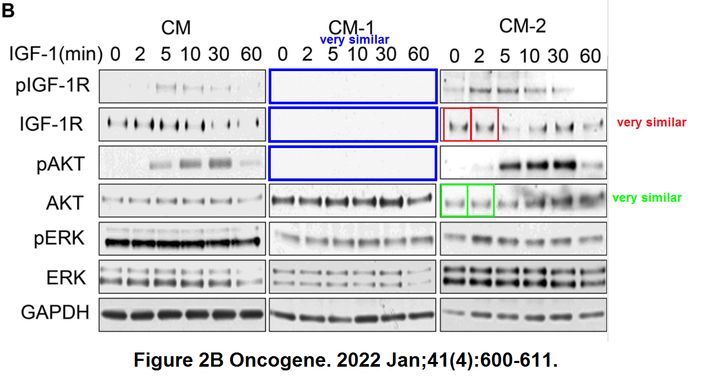
Regarding this paper, Welsh’s opinion was:
“…the expert believes that the suspicions regarding the images where
no signal is detected in Figure 2B are well-founded, that it is a question of incorrectly duplicated, thus falsified, images and that no conclusions can be drawn from the experiment.”
The authors were invited to oppose Welsh’s findings, which they did, see full report. He remained unconvinced, and described this duplication as “forgery / fabrication”.
The final verdict by NPOF was (highlights mine):
“The board has established that figure 2B contains falsified images, which are serious deviations from good research practice. It appears from the comments of the applicants and what is stated in the article that the following authors
have participated in the work by, among other things, collecting and checking the data that is the basis of the article: Sonia Cismas, Caitrin Crudden, Leonard Girnita, Dawei Song, Naida Suleymanova, Claire Worrall and Huiyuan
Zheng . Eric Trocme has spoken to the Board and stated that he did not participate in the experimental work or had access to the radar data. According to what is stated in the article, however, he has been responsible for both the collection and control of data.
The Board has judged that these people have had responsibility and several opportunities to check that the figures in the article were correct. They have also had the competence to do this. The board therefore assess that each of them has acted grossly negligently when they did not notice the falsified images before the article was published.According to what is stated in the article, Ada Gimita has not been responsible for checking the data, even if it can be judged to be within her competence. The name indicates that she has acted negligently, but not grossly negligent, when she has not pointed out the falsified images.”
Gross negligence means research misconduct, i.e. fraud. Negligence alone does not constitute fraud, but is a clear and potentially sanctionable deviation from good research practice. As in fact Welsh’s own boss, the rector of University of Uppsala Anders Hagfeldt recently learned:
Swedish rector Anders Hagfeldt pronounced innocent of papermilling
“The board’s conclusion is therefore that the deviations regarding figure 2b and 2c in article 1 constitute serious deviations from good research practice”
Now, it is all very nice to know that the paper is totally fraudulent, but you see, the journal Oncogene disagrees. A Correction was published already on 9 February 2023:
“Following the publication of this article, the authors noted errors in the assembly of Fig. 2b. A corrected version is provided in which the western blot panel for the cell line CM2 has been replaced with images from an alternative repeat for the pIGF1R/IGF1R and pAkt/Akt. In addition, the CM1 panel is updated with longer exposure images for pIGF1R/IGF1R and pAkt to better demonstrate the absence of IGF1R and IGF1-induced signaling activation in this cell line.
The description of the results and the figure legend remain unchanged, and the authors confirm that conclusions of this article are not affected by this correction. The authors apologize for any inconvenience this may have caused for readers.”
NPOF thinks that no conclusions can be drawn, Oncogene says they are not affected. After I received the NPOF report, I contacted the Girnitas and the publishers. Leonard Girnita then explained to me how to resolve this cognitive dissonance:
“1. The NPOF decision is not yet final. […]
3. The claims of unaffected conclusions for all listed papers are valid and these aspects were not challenged by the NPOF.
4. The basis for NPOF’s evaluation and COPE’s criteria are very different.”
Leonard Girnita
The NPOF misconduct findings, and those about very much affected conclusions, are actually rather final, they can only be appealed in administrative court, as in fact the former Karolonska rector Karin Dahlman-Wright did (for some reason successfully). Read here:
The Karin Dahlman-Wright Show
Karin Dahlman-Wright, Karolinska Institute’s former president, then vice-president, now rector’s counsellor was found guilty of research misconduct, again. This time in 4 papers. And then a Swedish court overturned everything and declared her innocent.
But in his last point it seems Girnita counts with the support of the publishers, as he already received for this paper. Oncogene is published by Springer Nature, whose Research Integrity Adviser told me:
“We will investigate them in line with COPE guidelines.”
Uh-uh. Always be wary when editors or publisher execs announce to investigate some fake papers “in line with COPE guidelines“. These guidelines are intentionally so loopy as to allow the journals to do whatever they feel like.
COPE, the publishers’ Trojan horse, calls to abolish retractions
Four private scientists without any agenda whatsoever published a research result preprint on the portal BioRxiv. The “new results” reported in the article are actually new ideas which are just as good as any research results, because they are supposed to bring the field of scholarly communication forward. The question is, where to, and why…
The other journals did not reply to me. Which is worrisome, because Girnita’s former mentor George Calin is senior editor of the AACR journal where paper Nr 2 was published, with Calin as coauthor.
Paper Nr 2:
Caitrin Crudden, Takashi Shibano, Dawei Song , Mihnea P. Dragomir , Sonia Cismas, Julianna Serly, Daniela Nedelcu, Enrique Fuentes-Mattei , Andrei Tica , George A. Calin , Ada Girnita, Leonard Girnita Inhibition of G Protein-Coupled Receptor Kinase 2 Promotes Unbiased Downregulation of IGF1 Receptor and Restrains Malignant Cell Growth Cancer Research (2021) doi: 10.1158/0008-5472.can-20-1662


In May 2022, the first author Caitrin Crudden wrote to me:
“Having now provided all necessary raw data and experimental evidence, as it currently stands the editor is satisfied that duplications in this instance were genuine mistakes and neither change any conclusions reported in the original paper, nor misrepresent true data.“
So there we have another case of cognitive dissonance. The NPOF investigator Welsh believes this paper (which KI celebrated in a press release in 2020) is fraudulent:
“the expert states that the images in figure 1B and 3D is a forgery. The
expert has found additional concerns about the data presented in figures 1B, 1D, 3B and 3D beyond the images which the notifiers found to be duplicated in figures 1B and 3D. The expert notes that some conclusions drawn in the article may not are correct because of this, and consider the images to be serious deviations from good research practice.”
After authors’ rebuttal Welsh found even more issues:
“Article 2 – For figure ID, the suspicions arise that the results for HEK and A673 cells cannot be confirmed by information from the lab notes. For figure 3B, the suspicions arise that the data provided by the applicants to the Board do not confirm what is alleged in the article. This means suspicions of forgery/fabrication that the figures 1D and 3B do not show what they are supposed to show.”
This was NPOF’s final verdict:
“The Board has established that Figure 1 B and 3D contain falsified images that constitute serious deviations from good research practice. It appears from the comments of the reviewers and what is stated in the article that the following authors have participated in the work by, among other things, examining and checking the data that forms the basis of the article: Sonia Cismas, Caitrin Crudden, Ada Gimita, Leonard Girnita, Daniela Nedelcu, Takashi Shibano and Dawei Song. These people have had responsibility and several opportunities to check that the figures in the article are correct. They have also had the competence to do this.
The Board therefore assess that each of them has acted grossly negligently when they did not point out the falsified images before the article was published.”
Julianna Serly was found of having “acted negligently, but not grossly negligently, when she did not notice the forged images.”
AACR conjures undead Count Fakula Michael Karin
What better distraction than the COVID-19 pandemic to revive one of the spookiest parasites in cancer research? AACR uses the COVID-19 cover to award Michael Karin, for his over 50-paper-strong record of data fakery.
Will MD Anderson’s professor Calin retract his own paper with Girnita? Your guess is a s good as mine.
Paper Nr 3:
Also the publisher of paper Nr 3 is conflicted. It was handled at PNAS by the academic editor Robert Lefkowitz, who is a Nobel Prize laureate and with whom Girnita used to collaborate. To retract that would mean to displease a Nobelist.
Huiyuan Zheng , Hongchang Shen , Iulian Oprea , Claire Worrall , Radu Stefanescu , Ada Girnita , Leonard Girnita β-Arrestin–biased agonism as the central mechanism of action for insulin-like growth factor 1 receptor–targeting antibodies in Ewing’s sarcoma Proceedings of the National Academy of Sciences (2012) doi: 10.1073/pnas.1216348110
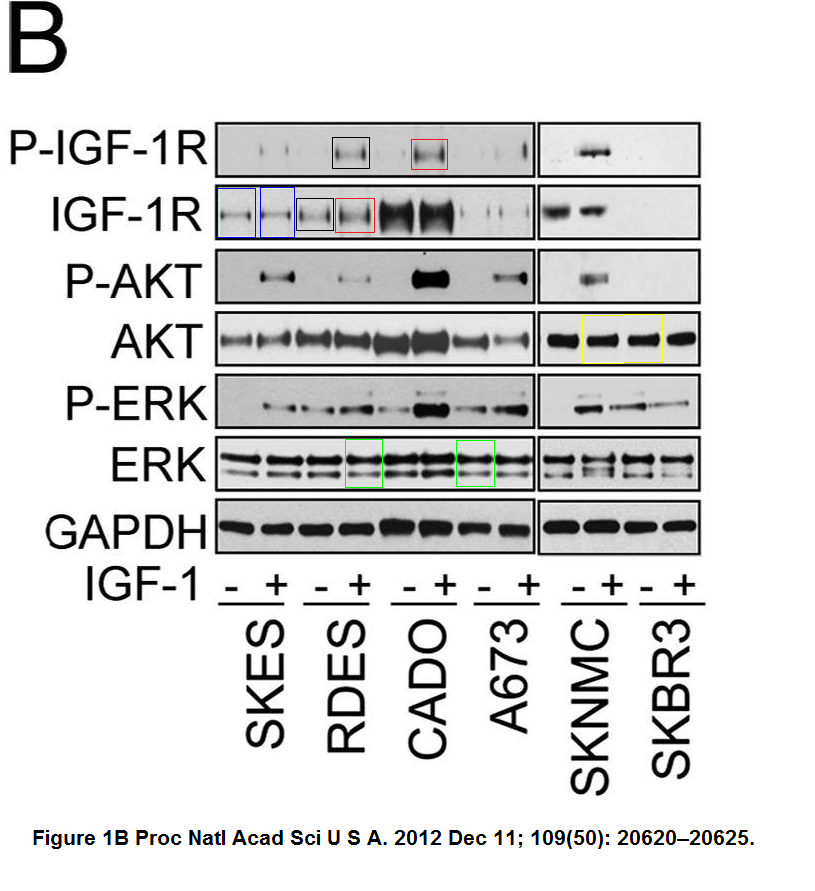






Welsh’s opinion was, quote:
- “Original data is missing for figure 1B, but that the data presented seems
correct after checking the published figure. - The suspicions against figure 2B are correct and the incorrect images for the protein IGF-1R and cell line SKNMC is counterfeit.
- The suspicions against Figure 3A are wrong based on checking the published figures.
- The suspicions against Figure 3C are wrong based on checking the published
figure. However, he notes problems with the attempts to reproduce the results presented by the authors in their opinions and does not consider the results to have been reproduced. - The suspicions against figure 4A are correct and the incorrect images for ß-arrestin l constitute forgery.
- In addition to this, the expert also believes that Figure 2C in Article 3 contains incorrect data.“
Also after authors’ rebuttal, Welsh insisted on his findings of “forgery / fabrication”. NPOF’s final verdict was:
“The Board has established that figures 2B and 4A contain falsified images that constitute serious deviations from good research practice. It appears from the statements of the complainants and what is stated in the article that all the following authors have been responsible for compiling the figures and writing the article: Ada Girnita, Leonard Girnita, Claire Worrall and Huiyuan Zheng. These people have had responsibility and several opportunities to check that the figures in the article are correct. They have also had the competence to do this. The Board judges that they all acted grossly negligent in not pointing out the forged
images before the article was published.”
Worth noting that thanks to this fake paper Huiyuan Zheng made it to assistant professor in Girnita’s lab at Karolinska. Iulian Oprea and Hongchang Shen were found to have “acted negligently, but not grossly negligently, when they did not highlight the falsified images before the article was published.” Radu Stefanescu was a visiting Erasmus doctoral student, his responsibility was therefore not established.
Time to Meditate
Merry Christmas from PNAS
Paper Nr 4:
Again, Oncogene.
C Worrall , N Suleymanova , C Crudden , I Trocoli Drakensjö , E Candrea , D Nedelcu , S-I Takahashi , L Girnita , A Girnita Unbalancing p53/Mdm2/IGF-1R axis by Mdm2 activation restrains the IGF-1-dependent invasive phenotype of skin melanoma Oncogene (2017) doi: 10.1038/onc.2016.472

Welsh’s opinion:
“Regarding Article 4 and the suspected figure 5A, the expert believes that the suspicions are correct and that the errors cannot have occurred by mistake. He finds additional problems with the data presented in Figures 3A and 5B.”
Welsh became even more concerned after receiving the authors’ opinions:
“Article 4 – For figure 3A , there are suspicions that not all the experiments that allegedly form the basis for the figure have been carried out. For Figure 5B, it is suspected that the experiments have not been carried out as claimed. This raises suspicions of forgery/fabrication that Figures 3A and 5B do not show what they claim to show.”
Yes, he accuses Girnitas and their co-authors to have fabricated the data and to have never performed the experiments as described. NPOF’s final verdict:
“It appears of the complainant’s statements that the following authors have participated in the work by, among other things, producing and examining the data that forms the basis of the article: Caitrin Crudden, Ada Girnita, Leonard Girnita, Daniela Nedelcu, Naida Suleymanova and Claire Worrall. These people have had the responsibility and opportunity to check that the figures in the a11icle are correct. They have also had the competence to do this. Because it is a single error that occurred in the final stages of the work on the article, the Board judges that they each acted negligently , but not grossly negligent, in not pointing out the forged images before the article was published.”
NPOF also lifted responsibility from Elisabeta Candrea (a visiting Erasmus doctoral student) and Iara Trocoli Drakensjo, who was only involved in some clinical aspects of the article. But because NPOF found “only” negligence, but not fraud, Girnita triumphantly told me:
“2. No scientific misconduct was found for Oncogene 2017 paper“
As reminder, the expert found out that experiments for Figure 3A were never done, certainly not as described.

Another investigation?
Girnitas’ mentor, the Karolinska emeritus professor Olle Larsson is apparently enjoying his freedom of responsibility. Their common papers on PubPeer are all older than 10 years. A perfect crime?
Look what utter fraud he and Girnita successfully corrected, again in Oncogene:
Daiana Vasilcanu, Ada Girnita , Leonard Girnita, Radu Vasilcanu, Magnus Axelson, Olle Larsson The cyclolignan PPP induces activation loop-specific inhibition of tyrosine phosphorylation of the insulin-like growth factor-1 receptor. Link to the phosphatidyl inositol-3 kinase/Akt apoptotic pathway Oncogene (2004) doi: 10.1038/sj.onc.1208065


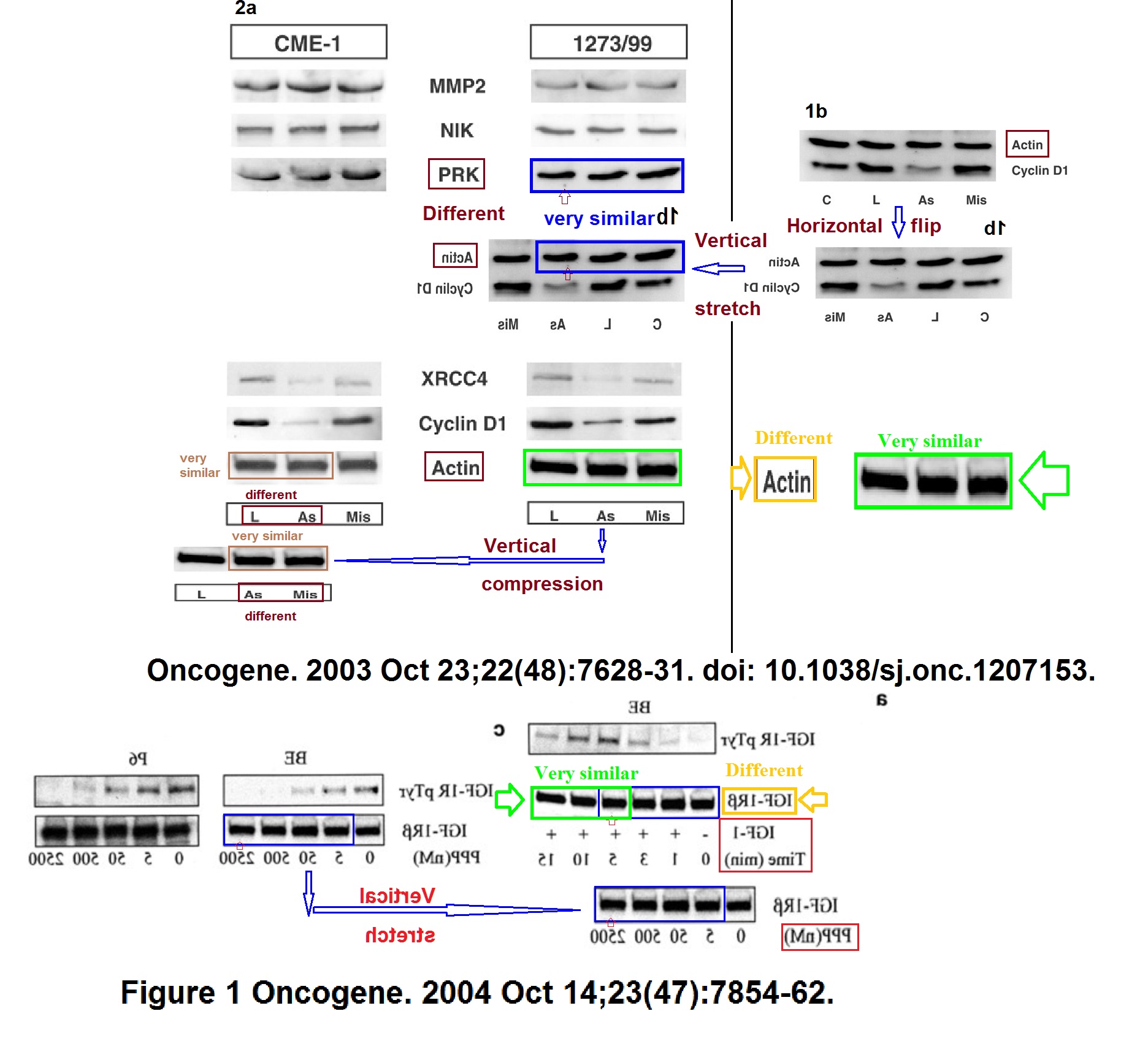
The correction was published on 16 December 2022:
“The authors have become aware of errors in three of the figures (Fig. 1a, Fig. 4c, and Fig. 5a) in this publication.
In Fig. 1a, the quality control panel (IGF-1Rb) was incorrectly cropped in the original publication. As a sample quality control was also performed by measuring the protein concentration of each sample, the authors have now chosen to remove this panel.
In Fig. 4c, the loading control (Akt) panel for P6 cell line was incorrectly cropped in the original publication. This panel and the corresponding pAkt panel have now been deleted.
In Fig. 5a, the loading controls (BAD panels) for BE and R-, detected on the same film were horizontally flipped and swapped through erroneous reverse scanning process. The figure is now corrected.
The authors have provided the corrected figures below. These corrections have no impact on the results or conclusions presented in this paper. The authors apologize for the errors, and regret any inconvenience this may have caused for the readers.”
And yet, hope is not lost. This Girnita-Larsson paper in Oncogene received an Expression of Concern:
Yuntao Xie , Maria Törnkvist , Yan Aalto , Gunnar Nilsson, Leonard Girnita , Bálint Nagy , Sakari Knuutila, Olle Larsson Gene expression profile by blocking the SYT-SSX fusion gene in synovial sarcoma cells. Identification of XRCC4 as a putative SYT-SSX target gene Oncogene (2003) doi: 10.1038/sj.onc.1207153
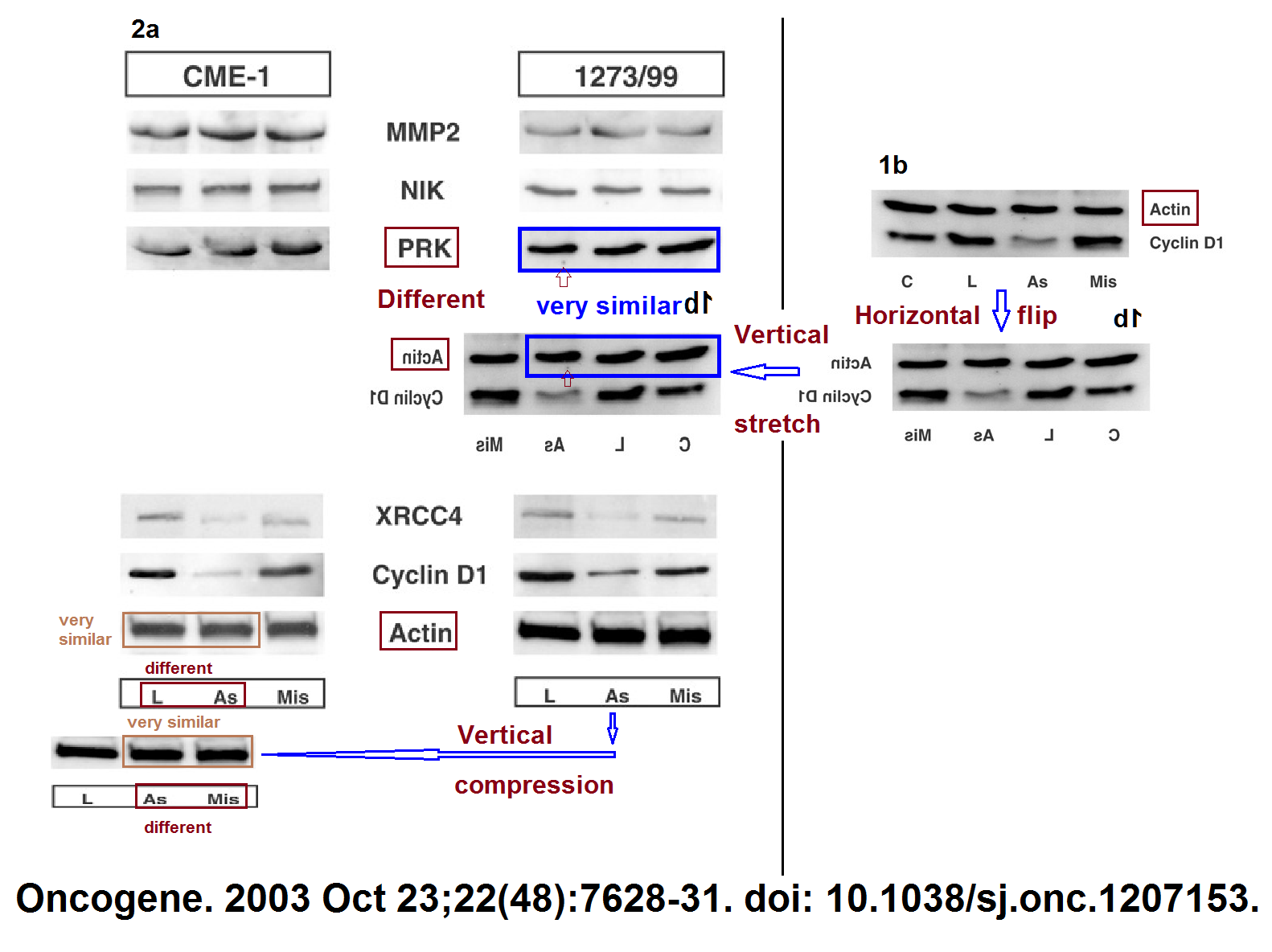
The editorial Expression of Concern appeared in November 2022:
The Editors would like to alert the readers that concerns have been raised regarding the data presented in this article. Specifically:
- Fig. 1b Actin (flipped horizontally) and Fig. 2a PRK bands appear to share a number of background features, as well as similar band shapes;
- Fig. 2a and b appear to have breaks in the western blot backgrounds.
The authors have stated that the images in Figs. 1b and 2a are similar, but not identical, and attributed the background inconsistencies in Fig. 2 to loss of image quality during figure processing.
As the raw data for this article are no longer available due to the age of the study, readers are advised to interpret the presented results with caution.
Maria Dollhopf (formerly Maria Törnkvist), Sakari Knuutila and Olle Larsson agree to this Editorial Expression of Concern. Yuntao Xie, Gunnar Nilsson, and Leonard Girnita have not responded to any correspondence from the editor or publisher about this Editorial Expression of Concern. The Publisher has not been able to obtain a current email address for Yan Aalto and Bálint Nagy.
Nothing happened for over a year, to be fair. We may be expected to interpret Larssen’s and Girnita’s science with caution for all eternity.
And yet, and yet, there was even a retraction! The Girnita couple lost a paper, in Oncogene as it happens, also an older one. Which makes me think there must be another investigation at Karolinska Institutet, and Girnita refused to deny this theory (or to comment on his employment perspectives at this elite Swedish university).
So here is the recently retracted paper:
A Girnita , H Zheng , A Grönberg , L Girnita , M Ståhle Identification of the cathelicidin peptide LL-37 as agonist for the type I insulin-like growth factor receptor Oncogene (2012) doi: 10.1038/onc.2011.239
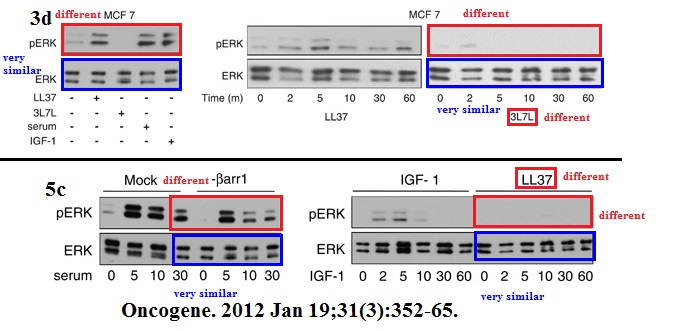
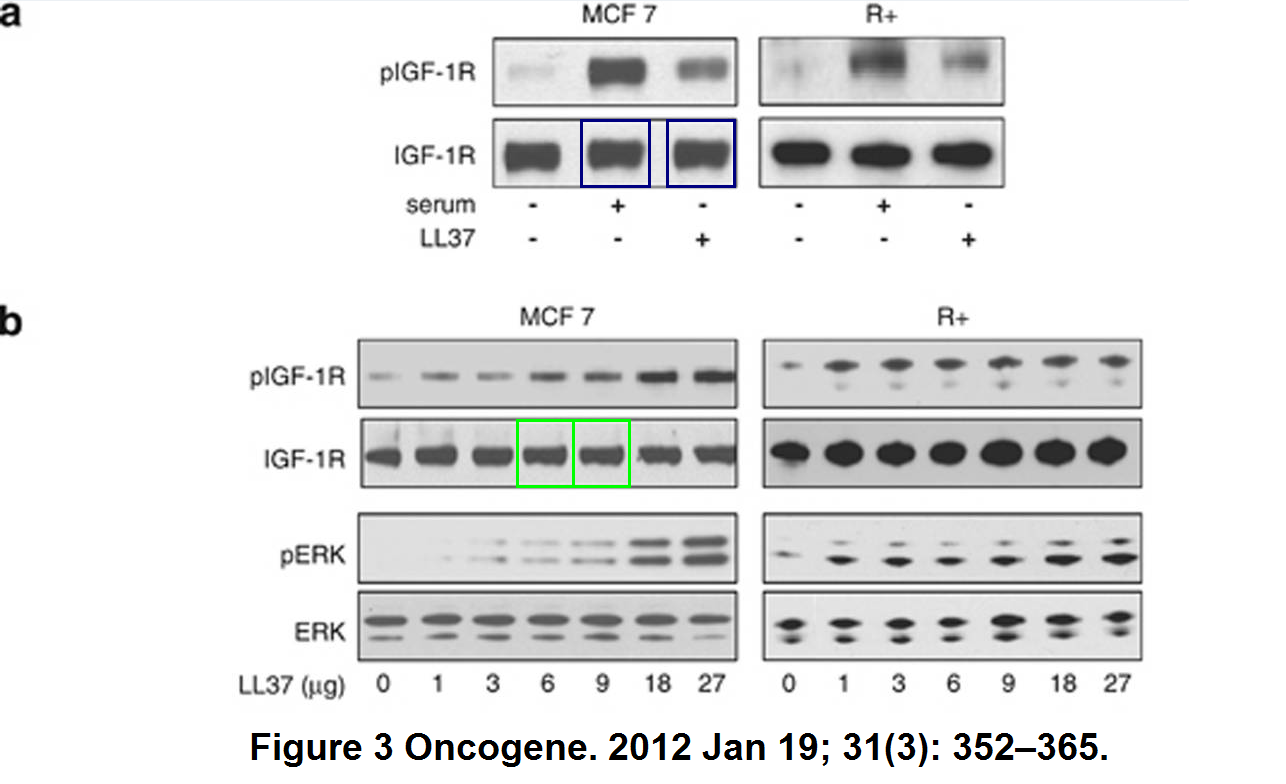
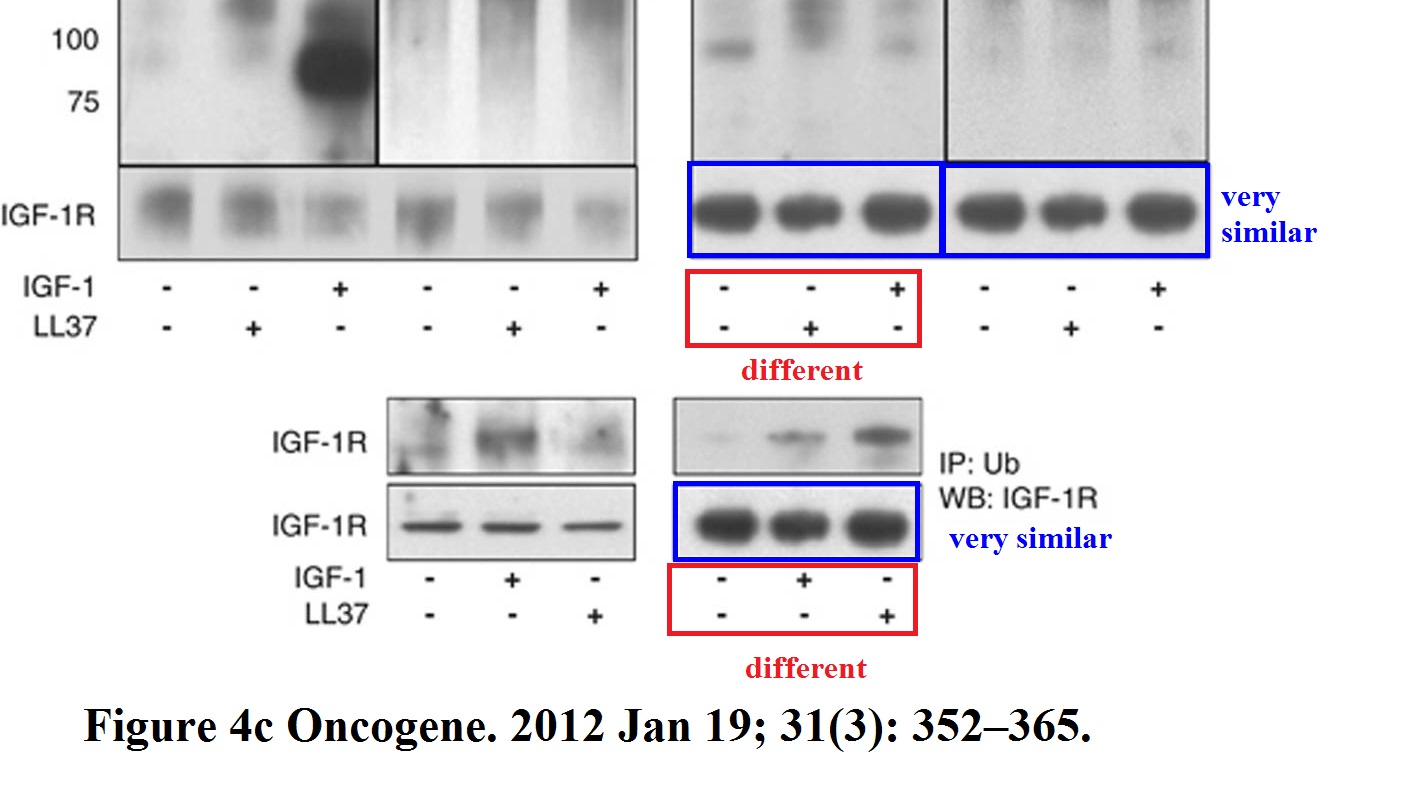

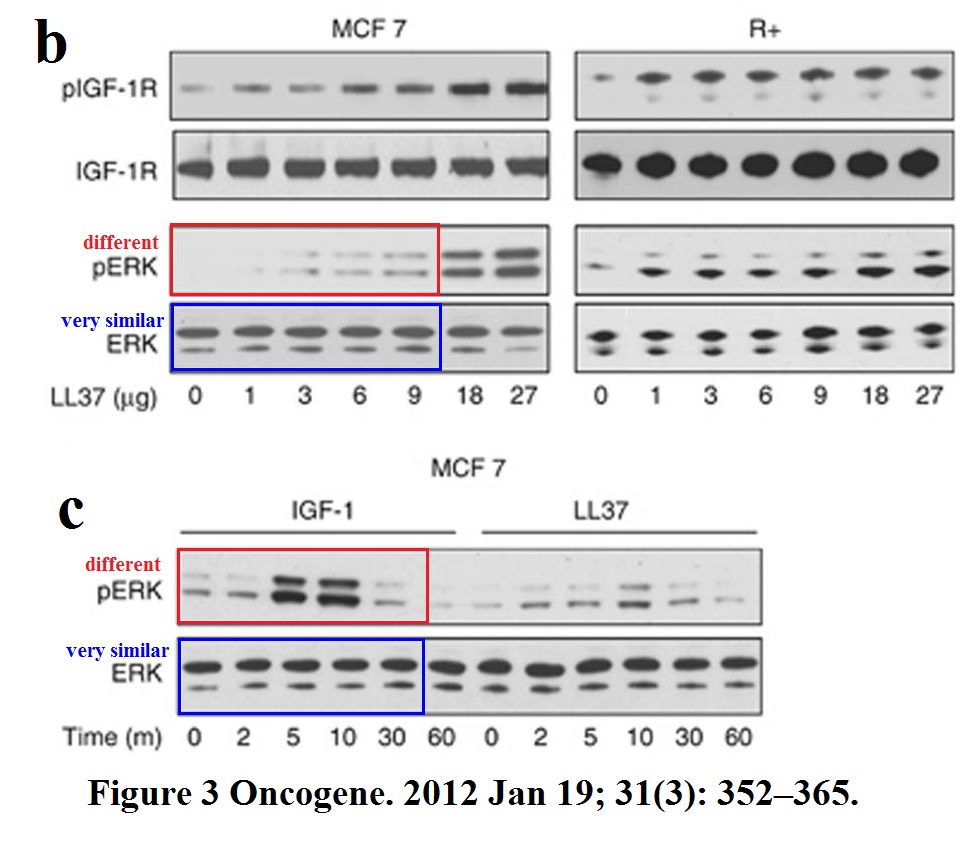
This was the retraction notice from 9 December 2022:
“The editors have retracted this article. Concerns were raised regarding a number of figures, specifically:
In Fig. 3A, the MCF 7 IGF-1R blot lanes 2 and 3 appear highly similar.
In Fig. 3B, yhe MCF 7 IGF-1R blot lanes 4 and 5 appear highly similar.
The MCF 7 ERK western blot lanes 1-5 in Fig. 3B appear highly similar to those in Fig. 3C.
The MCF 7 ERK blots in Fig. 3D (left and right) appear highly similar to those in Fig. 5C (left, lanes 4-8 and right, lanes 7-12).
In Fig. 4C, the R+ IGF-1R blots in the –PI and +PI groups, as well as those in the bottom right panel, appear highly similar.
In a number of western blot images, bands were removed to avoid sample duplication or in order to rearrange the grouping.
The authors have provided some of the original data from this study to address these concerns. However, due to a large number of issues, the editors no longer has confidence in the reliability of the data reported in the article.
A Girnita, M Ståhle, A Grönberg and L Girnita do not agree to this retraction. H Zheng has not responded to correspondence regarding this retraction.”
I struggle to believe it was Oncogene‘s Editor-in-Chief Justin Stebbing who decided to retract this paper all by himself. After all, two others were corrected in parallel.
Oncogene EiC Justin Stebbing, a hypocrite of research integrity?
‘The results have been replicated by ourselves or others, so the image manipulation is irrelevant.’ – Justin Stebbing, double bluffing
Let’s see how this continues. Maybe the Girnitas will end up back in Romania?
I thank all my donors for supporting my journalism. You can be one of them!
Make a one-time donation:
I thank all my donors for supporting my journalism. You can be one of them!
Make a monthly donation:
Choose an amount
Or enter a custom amount
Your contribution is appreciated.
Your contribution is appreciated.
DonateDonate monthly
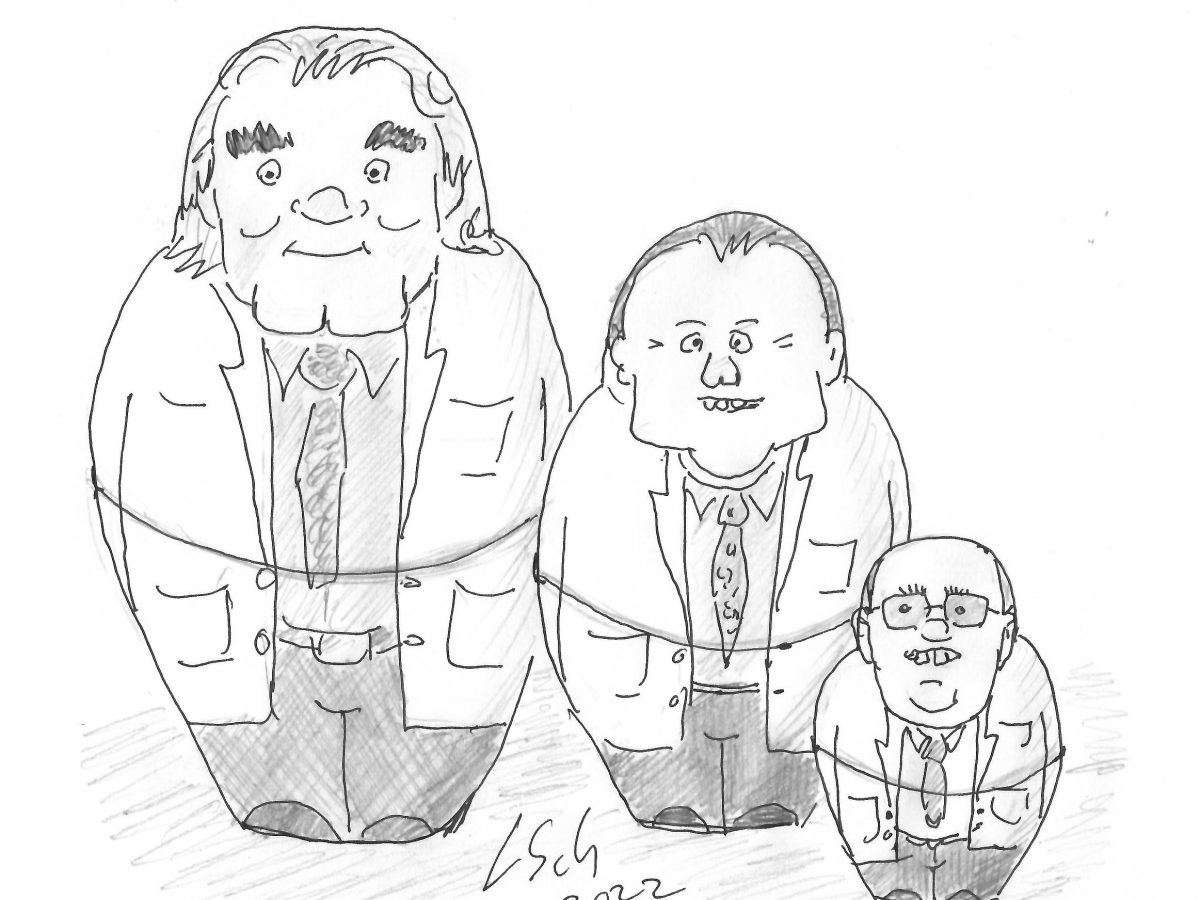





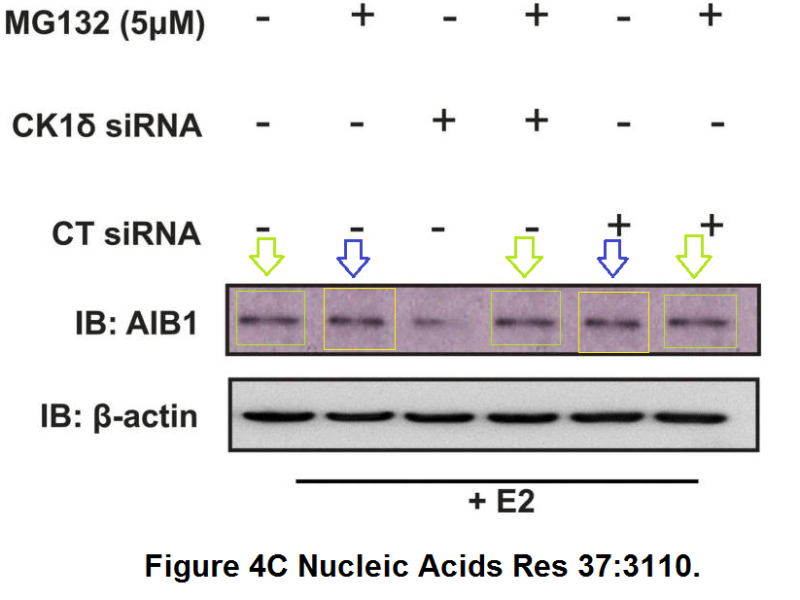

While Leonid is still tirelessly on the spot as of December 18th, big professors are on holidays for a couple of weeks already and will return in mid-January. Yearly free days is a very stretchable concept for them. Poor souls, they need to recharge after so much hard intellectual work. Will the Girnitas return too, though?
LikeLiked by 1 person
Well, actually I asked Girnita if he will continue being employed by Karolinska. Of if he still is employed there. He remained silent.
LikeLike
The ten-year rule should be scrapped. Papers are part of the scientific record forever. It’s pretty obvious that a good strategy to get ahead in science is to fake it until you make it, then spend the next 40 years phoning in compliant but useless papers, jetting off to conference every few weeks.
LikeLike
See you in Bali next week!
LikeLike
In the hot tub!
LikeLike
“His wife [Ada Girnita] used to be a regular feature on Swedish TV and radio. The melanoma expert was advising viewers on sun exposure (for example here , here, here and here). Who could have known that the real danger to public health was not in the mild Swedish summers, but in the fake cancer research Ada Girnita and her husband published?”
One of Swedish TV and radio’s literary programs should invite Ada Girnita to take part on a discussion on new avenues in Nordic Noir. Does life imitate art? Has scientific misconduct already been the topic of Nordic novels? What is the place of women in Nordic Noir? Is it old-fashioned to be binary?
What Nordic crime novel would Ada Girnita recommend as an introduction to the genre?
LikeLiked by 1 person
It seems that the NPOF investigation was initiated by Leonid Schneider and Clare Francis making complaints.
How come the Karolinska Institute didn’t notice the problematic data? What kind of game is the Karolinska Institute playing?
Let sleeping dogs lie? Keeping quiet and hope nobody notices, or simply no quality control whatsoever?
LikeLike